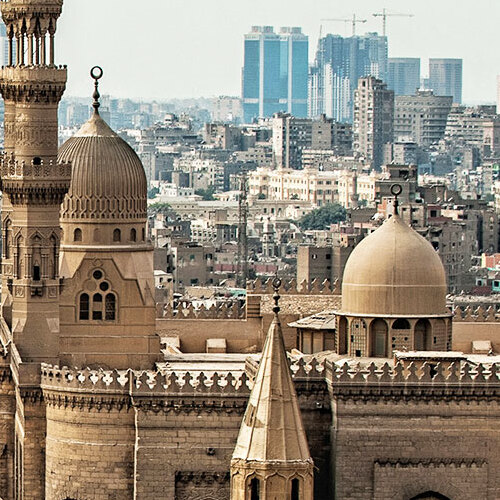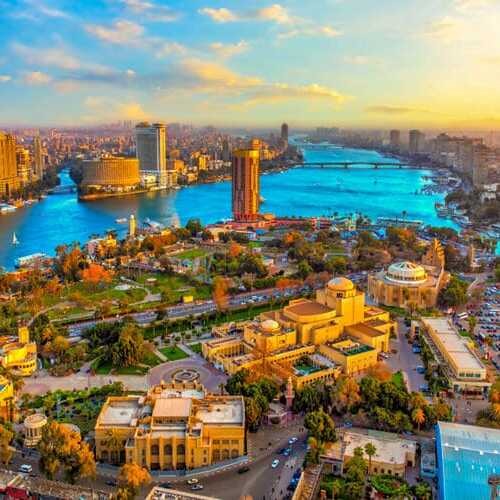No other nation in the world says ‘Welcome’ as often as the Egyptians, and every time, they mean it. While the ancient civilization of Egypt continues to amaze, contemporary Egyptians are equally remarkable.
Khan Al-Khalili Bazaar
Khan Al-Khalili Bazaar: Cairo's Timeless Marketplace
Khan el-Khalili Bazaar, nestled in the heart of Cairo, Egypt, stands as a renowned marketplace and traditional souq. Originally founded as a trading hub during the Mamluk period, and named after one of the historic inns in the vicinity, this bustling bazaar has evolved into a prime destination for both visitors and locals. It’s a vibrant center where Egyptian craftsmen and workshops bring traditional handicrafts and souvenirs to life. While ‘Khan el-Khalili’ once denoted a singular structure, it now encompasses the whole shopping area, drawing people into its rich history and cultural tapestry.
Fatimid Foundations: The Origins of Cairo
In the era of the Fatimids, between the 10th and 12th centuries, the area now known as Khan el-Khalili played a significant role in the foundation of Cairo. Established in 969 CE as the capital of the expansive Fatimid Caliphate, which spanned across North Africa and into parts of the Levant and the Hijaz, Cairo was born from the vision of Jawhar Al-Siqilli. This general, under Fatimid command, was tasked with building an impressive palace complex to accommodate the caliphs, their household, and the governmental bodies of the state. The completion of two grand palaces, an eastern and a western, marked the construction, with a plaza called Bayn al-Qasrayn (“Between the Two Palaces”) nestled between them. The location where Khan el-Khalili stands today was once part of the eastern palace’s southern end, also serving as the Fatimid caliphs’ burial ground within the Turbat az-Za’faraan (“the Saffron Tomb”), and included a smaller palace, al-Qasr al-Nafi’i, which is now the site of the 19th-century Wikala of Sulayman Agha al-Silahdar.
During the Fatimid era, Cairo was a closed palace-city, accessible only to the Caliph’s family, state officials, army regiments, and essential personnel. It wasn’t until the later years of Fatimid rule that efforts were made to open the city to merchants and outsiders, initiated by influential viziers. Between 1087 and 1092, Badr al-Gamali, a vizier for Caliph al-Mustansir, expanded the city, building its stone walls and gates, some of which survive today, and initially opened the city to the public before the policy was reversed. Later, between 1121 and 1125, al-Ma’mun al-Bata’ihi, vizier for Caliph al-Amir, implemented reforms and launched construction projects that introduced foreign trade to Cairo’s core. This included the establishment of a mint, the Dar al-Darb, and a customs house, the Dar al-Wikala, near the site of the later 15th-century Madrasa of al-Ashraf Barsbay, marking the beginning of foreign trade’s integration into the city’s heart.
Cairo's Economic Rise: From Fatimid to Mamluk Era
From the 12th to the 14th century, Cairo transitioned into a vibrant economic hub under the leadership of Salah ad-Din (Saladin), who, after ending the Fatimid Caliphate in 1171, initiated significant changes by building a new fortified Citadel to the south of the city walls. This move signaled the opening of the previously exclusive Fatimid palaces for redevelopment, transforming Cairo from a secluded palace-city into a bustling economic center accessible to the general Egyptian populace and foreign visitors alike. Meanwhile, the nearby port city of Fustat, once Egypt’s economic heart, saw a gradual decline, further cementing Cairo’s rising prominence.
The transformation was notably evident along the city’s main north-to-south thoroughfare, the Qasaba (present-day al-Muizz Street), stretching between the gates of Bab al-Futuh and Bab Zuweila and weaving through Bayn al-Qasrayn. This period under the Ayyubids and later the Mamluks saw this avenue become a favored spot for erecting religious complexes, royal mausoleums, and various commercial ventures, often sponsored by the sultan or the elite. It was along this stretch that Cairo’s major souqs sprung up, establishing the area as a key zone for international trade and business activities.
A crucial component in developing Cairo’s economic landscape was the proliferation of waqf institutions during the Mamluk era. Waqfs, or charitable trusts as defined by Islamic law, supported the construction and operation of numerous religious and civic buildings by the ruling class, with funding often derived from the revenues of specific shops or commercial ventures. One notable early example was the complex of Sultan Qalawun, constructed in 1284-85, which encompassed a madrasa, hospital, and mausoleum. Its maintenance was partially funded by the income from a qaysariyya (a market complex) built in proximity to the Ayyubid-era madrasa of al-Salih. Situated along the Qasaba, this qaysariyya exemplified the kind of dedicated commercial structures that emerged in Cairo, fostering the city’s evolution into a thriving economic center under Mamluk governance.
The Mamluk Era: Architectural Evolution of Khan al-Khalili
In the Mamluk period, spanning the 14th to 15th centuries, the landscape of Cairo underwent significant changes, particularly along the bustling Qasaba avenue. As the street became increasingly crowded with the construction of new buildings and the disappearance of open spaces, the focus of commercial development shifted eastward, nearer to al-Azhar Mosque and the shrine of al-Hussein, where room for expansion still existed. The traditional souq areas, once filled with temporary market stalls, began to be replaced by permanent stone structures. These buildings, designed with integrated shops, were a response to the authorities’ desire for more control over commercial activities, allowing for easier taxation and regulation compared to the ephemeral nature of market stalls.
To accommodate the city’s growing density and scarcity of space, architects and builders turned to constructing multi-story buildings known as khans or wikala, serving as caravanserais with accommodations for merchants. These structures featured an inner courtyard for storage and upper levels for living quarters, with shop spaces often lining the street-facing sides. This architectural innovation allowed for the expansion of commercial zones through the interconnected areas around multiple khans.
During the reign of Sultan Barquq, the first Burji Mamluk sultan, despite the devastating impact of the Black Death, Egypt remained a vibrant economic hub, with the construction of commercial and religious buildings continuing. It was in this period that Jaharkas al-Khalili, Barquq’s Master of the Stables, demolished the Fatimid mausoleum, Turbat az-Za’faraan, to construct a large khan that would bear his name, Khan al-Khalili, thereby establishing a new commercial center in the heart of Cairo. This name eventually came to represent the entire district, with al-Khalili controversially disposing of the Fatimid royal family’s remains.
The trend of building commercial structures continued under later Mamluk rulers. For instance, during the era of Sultan Qaytbay, one of his amirs, Yashbak min Mahdi, erected the Rab’ al-Badistan, a residential complex for tenants across from Khan al-Khalili, while Qaytbay himself built the Wikala of Sultan Qaytbay further east, near al-Azhar Mosque. By the late 15th century, the area surrounding Khan el-Khalili had developed into a major center for foreign trade, including transactions involving slaves and precious stones, reflecting its importance in Cairo’s economic landscape.
Sultan al-Ghuri's Legacy: Redefining Cairo's Commercial Landscape
In the dawn of the 16th century, Sultan al-Ghuri, marking his reign as the last effective Mamluk sultan of Egypt from 1501 to 1516, embarked on an ambitious project to transform the district’s landscape with a sweeping redevelopment campaign. His efforts included the construction of his own religious and funerary complex, along with a grand Wikala named in his honor. A significant part of this transformation involved demolishing the original khan established by al-Khalili and erecting a new structure in 1511, which for many years was known as the Khan al-Fisqiya (“Khan of the Fountain”). This name persisted until it was later referred to as the Wikala al-Qutn (“Wikala of Cotton”).
Al-Ghuri’s redevelopment extended beyond individual buildings; he reshaped the adjacent areas into a souq, the Suq al-Nabulsi, which he distinguished with monumental stone gates. His vision included implementing a more systematic grid plan for the district, lending a sense of order and coherence to the urban fabric. This redesign featured elements reminiscent of a bedesten—found in Ottoman cities—a centralized bazaar dealing in valuable goods, often characterized by covered streets and gates that were secured at night. It’s speculated that al-Ghuri’s efforts might have been inspired by similar commercial hubs in major Ottoman cities, especially considering the period’s intense rivalry between the Ottoman Empire and the Egyptian Mamluk state, alongside the growing presence of Turkish merchants in Cairo.
Today, remnants of Sultan al-Ghuri’s ambitious undertakings are still visible, including the Suq al-Nabulsi with its two elaborately crafted stone gates, and the façade and entrance of the Wikala al-Qutn. These historic landmarks line the street known as Sikkat al-Badistan. The western gate, originally called Bab al-Silsila but now known as Bab al-Badistan, and the eastern gate, formerly Bab al-Nuhhas and currently Bab al-Ghuri, stand as enduring testaments to a time of transformative urban development in Cairo.
Created On May 4, 2020
Updated On January 26, 2024
CAIRO Travel Guide
The Complex of Sultan Ashraf Barsbey
Khanqah-Mausoleum of Farag Ibn Barquq
Mosque-Madrassa of Sultan Hassan
Mosque-Madrassa of Umm Sultan Sha’aban
Beit Al-Suhaymi(Al-Suhaymi House)
Khanqah & Mausoleum of Sultan Baybars al-Gashankir
Sabil And Kuttab Of Abdel Rahman Katkhuda
Madrassa And Mausoleum of An-Nasir Mohammed Sultan
Madrassa And Mausoleum of Barquq
Madrassa & Mausoleum of as-Salih Ayyub
Bein al-Qasreen STREET(Between The Two Palaces {Street})
Madrassa & Mausoleum of Qalawun
Midan Al-Hussein(Sayedna Al-Hussein Square)
Khan Al-Khalili Bazaar (Cairo’s Most Famous Bazaar)
The Church of St Sergius & Bacchus



